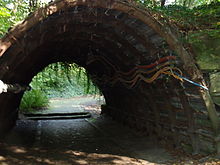Plain bend extension
The sliding arch extension is a type of extension that is used in mining as a route extension . This expansion is a multi-part and flexible expansion.
construction
In the case of a sliding arch extension, each extension arch consists of several channels that can be slid into one another. Different profiles are used, which are manufactured either as TH standard profiles, as V-profiles or bell profiles. There are also plain arch extensions with two, three or four-part extensions, of which the three-part design is the most common. The shapes of the plain bend extension can be either symmetrical or asymmetrical. The connection of the individual expansion segments is carried out differently depending on the profile type. There is the flexible clamp connection, in which no screws are required, but the arch segments are attached using a swivel wedge. With another type of fastening using screw connections, special friction locks are used for fastening, which are matched to the respective extension profile. In order to protect the individual structures against shear forces in the longitudinal direction, they must be provided with a bolt as a longitudinal stiffener.
Mode of action
The plain arch support is designed in such a way that it enables the load to be absorbed as a result of the rock pressure through friction between the overlapping arch segments. When pressure is applied from above, the segments are shifted into one another depending on the strength of the pressure. This results in a reduction in the cross-section of the route , but the individual expansion segments are not deformed by the rock pressure . In order for this resilience of the extension to work properly, the resilient connection points must be in the main pressure direction as far as possible; they must therefore run perpendicular to the hanging wall. In addition, the clamp connections must be resilient and allow the overlapping segment ends to work well. In order to make this possible, the connections must move securely with the profiles and not get stuck on warpage .
Use and problems
Plain bend lining is mainly used in mining routes . Three -part symmetrical expansion is used in expansion stretches of flat storage . The three-part asymmetrical extension is suitable for mining sections of inclined storage. Two-part asymmetrical expansion is used in expansion sections of the steep storage. Incorrect installation of the connection locks can lead to problems when extending the route with sliding arch construction. This is e.g. B. the case when the screw tightening torques are impermissible and the screws are not tightened according to the manufacturer's instructions. The use of unsuitable assembly devices, with which the necessary clamping force cannot be provided, also leads to impairment of the sliding arch construction. Other problems can arise if the sliding arch connections are not properly created. If the segments are installed in such a way that the direction of the channels does not match the main pressure direction, the expansion of sliding friction cannot work properly. This incorrect installation makes pushing the individual expansion segments together very difficult. As a result, there can be significant deformations in the route extension. When screws of Gleitbogenausbaus the tension in the connections Gleitbogenausbaus can jump up abruptly. This has the consequence that screws fly off, tabs jump off or components knock back. If people are hit by these parts, they can be seriously injured or even killed.
Individual evidence
- ^ A b Walter Bischoff , Heinz Bramann, Westfälische Berggewerkschaftskasse Bochum: The small mining dictionary. 7th edition, Verlag Glückauf GmbH, Essen 1988, ISBN 3-7739-0501-7 .
- ^ A b c d Carl Hellmut Fritzsche: Textbook of mining science. Second volume, 10th edition, Springer Verlag, Berlin / Göttingen / Heidelberg 1962.
- ↑ Friction lock without driver and open profile connection for channel profiles. Patent Specification No. DE19837907A1 November 11, 1999 (accessed November 25, 2011).
- ↑ Alexander H. Schneider: Security against collapse in underground mining. ETH dissertation No. 14556, Institute for Geotechnics, vdf Hochschulverlag AG at ETH Zurich, Zurich 2002, ISBN 3-7281-2872-4 .
- ↑ Heinz M. Hiersig (Ed.): VDI-Lexikon Maschinenbau. VDI-Verlag GmbH, Düsseldorf 1995, ISBN 9783540621331 .
- ↑ Collective sheet of the Arnsberg district government, Department 6: Use of sliding arch extensions (accessed on November 25, 2011).
- ↑ Collective sheet of the Arnsberg district government Department 6: Safety when loosening the connections on the sliding bend extension (accessed on November 25, 2011).



